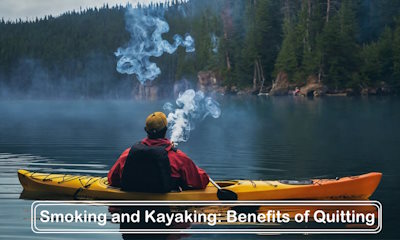Nearly 18.6 million Americans went kayaking in 2021, and that number only continues to grow. Kayaking is becoming more popular because it seamlessly combines physical activity with the ability to connect with nature, as noted in a recent Business Wire report. Meanwhile, there were an estimated 57 million smokers in the US in 2023. Given these large numbers, it’s reasonable to assume that many smokers are also avid kayakers, especially since both kayaking and smoking are used as stress-relief mechanisms.

But with so many rivers, lakes, and coastlines to exposure, kayaking can be incredibly hard on the body, especially as you level up to more challenging waterways. As such, ensuring you have the best odds at enjoying your outdoor paddling adventures by nipping your cigarette habit in the bud is crucial.
Table of Contents
Negative effects of smoking for kayakers
Your breathing plays a huge role in your paddling, ensuring your muscles get enough oxygen to paddle longer and more powerfully. It also engages your core, which is invaluable for stability and balance—especially when waters get rough. Unfortunately, the tobacco in cigarettes impedes lung function and can damage the airways and small air sacs, or alveoli, in the lungs. Particulate matter (PM) 2.5, which is a major component of both cigarette smoke and environmental tobacco smoke, can cause shortness of breath and the worsening of chronic conditions like asthma. When a person cannot breathe enough and with ease, it can limit the oxygen the muscles receive while kayaking.

An Endocrinology and Metabolism report found that smoking reduced the production of proteins necessary to repair muscles while suppressing the genes that maintained muscle mass. The progressive loss of lean muscle and impaired oxygen distribution can result in less efficient paddling. This can cause kayakers to cover shorter distances, get tired more quickly, and experience discomfort that ruins their experience. Given these consequences, smoking cessation should be done sooner rather than later.
Best quit methods for kayakers
For some smokers, going cold turkey is the best way to quit as it just eliminates the temptation altogether. However, since many smokers have a dependence, it’s more sustainable to first transition to smokeless alternatives. To illustrate, nicotine pouches on Prilla demonstrate that nicotine pouches from well-known brands like ZYN, On!, Rogue, and VELO are discreet tobacco- and smoke-free replacements. These come in different strengths and flavors, including ones like Wintergreen 6mg, which can be an invigorating medium-strength option for kayakers. Pouches are also hands-free, making them ideal for kayakers who need both hands.
Nicotine patches are another hands-free option for prospective quitters. Because they can be placed discreetly under clothing, kayakers need not worry about being unable to leave the water for a smoke break. One example is the Nicorette nicotine patches. Since these release nicotine gradually over sixteen hours, it can help kayakers get accustomed to smaller amounts of nicotine before quitting entirely. It’s also helpful on extended paddling trips, as you don’t have to keep removing them throughout the day.

Finally, you can meet the physical demands of kayaking trips and potentially mitigate cravings by engaging in endurance and strength workouts. Some exercises that strengthen the upper body include rows, pull-ups, planks, deadlifts, and Russian twists. These will keep you balanced, even in rougher waters. In a previous article by Max Richardson, we discussed how rhythmic paddling can elevate your heart rate and increase stamina. To support your endurance, engage in running, cycling, or swimming. The key is to incorporate them equally to have a good combination of strength, stamina, and flexibility for the rough waters ahead. As exercising helps release endorphins, you’re also less likely to experience some withdrawal symptoms.
Looking after yourself by dropping unhealthy habits and keeping active while on land is a surefire way to keep you paddling on. The sooner you quit cigarettes, and the more you kayak, the sooner you can help your body return to a healthier state. For more kayaking tips, visit KayakStar.
FAQ
How does smoking affect kayaking performance?
Smoking can significantly impact kayaking performance in several ways. Firstly, smoking reduces lung function and overall cardiovascular health, leading to decreased endurance and stamina while paddling. Carbon monoxide in cigarette smoke displaces oxygen in the bloodstream, reducing the oxygen available to muscles during physical activity, which can lead to fatigue and decreased performance. Additionally, smoking can impair lung function and increase the risk of respiratory issues, such as shortness of breath and coughing, which can hinder breathing efficiency while kayaking. Moreover, smoking is associated with decreased athletic performance, slower reaction times, and impaired coordination, all of which are crucial for navigating waterways safely and effectively. Therefore, quitting smoking can significantly improve kayaking performance by enhancing lung function, increasing endurance, and reducing the risk of respiratory issues, ultimately allowing kayakers to enjoy their sport to the fullest.
What are the health benefits of quitting smoking before kayaking?
Quitting smoking before kayaking offers numerous health benefits. Firstly, it improves lung function and increases lung capacity, enhancing breathing efficiency during physical activity. This leads to improved endurance and stamina while paddling, allowing kayakers to enjoy longer and more fulfilling excursions on the water. Additionally, quitting smoking reduces the risk of respiratory issues such as shortness of breath, coughing, and wheezing, which can interfere with breathing and diminish overall performance on the water. Moreover, quitting smoking lowers the risk of developing serious health conditions such as heart disease, stroke, and lung cancer, thereby improving overall health and well-being. By quitting smoking before kayaking, individuals can experience improved lung function, increased energy levels, and better overall fitness, allowing them to fully enjoy their time on the water while minimizing the risk of health complications associated with smoking.
Can smoking impact safety while kayaking?
Yes, smoking can impact safety while kayaking in several ways. Firstly, smoking increases the risk of fire-related accidents if a lit cigarette comes into contact with flammable materials such as clothing, equipment, or the kayak itself. Moreover, smoking can impair coordination and reaction times, making it more difficult for kayakers to respond quickly to changing water conditions or obstacles, increasing the risk of accidents or collisions. Additionally, smoking can lead to decreased lung function and respiratory issues, such as shortness of breath or coughing, which can hinder breathing efficiency and increase the likelihood of fatigue or exhaustion while paddling. Furthermore, smoking increases the risk of developing serious health conditions such as heart disease and stroke, which can pose additional safety concerns while engaging in physically demanding activities like kayaking. Overall, quitting smoking can help improve safety while kayaking by reducing the risk of fire hazards, improving coordination and reaction times, and enhancing overall lung function and respiratory health.
Does smoking decrease endurance for kayaking?
Yes, smoking can decrease endurance for kayaking. Smoking leads to decreased lung function and cardiovascular health, reducing the body’s ability to efficiently deliver oxygen to muscles during physical activity. This diminished oxygen supply results in decreased endurance and stamina while paddling, leading to quicker fatigue and reduced performance on the water. Additionally, smoking increases the risk of respiratory issues such as shortness of breath and coughing, further hindering breathing efficiency and decreasing endurance during kayaking. Therefore, quitting smoking can significantly improve endurance for kayaking by enhancing lung function, increasing cardiovascular fitness, and reducing the risk of respiratory issues, allowing kayakers to paddle longer distances with greater ease and enjoyment.
Are there specific risks of smoking while kayaking?
Yes, there are specific risks associated with smoking while kayaking. Firstly, smoking increases the risk of fire-related accidents if a lit cigarette comes into contact with flammable materials such as clothing, equipment, or the kayak itself. Additionally, smoking can impair coordination and reaction times, making it more difficult for kayakers to respond quickly to changing water conditions or obstacles, increasing the risk of accidents or collisions. Moreover, smoking can lead to decreased lung function and respiratory issues, such as shortness of breath or coughing, which can hinder breathing efficiency and increase the likelihood of fatigue or exhaustion while paddling. Furthermore, smoking increases the risk of developing serious health conditions such as heart disease and stroke, which can pose additional risks while engaging in physically demanding activities like kayaking. Overall, smoking while kayaking can increase the risk of fire hazards, impair coordination and reaction times, decrease lung function and respiratory efficiency, and pose additional health risks, highlighting the importance of quitting smoking for the safety and well-being of kayakers.
How does smoking cessation improve kayaking skills?
Smoking cessation can significantly improve kayaking skills in several ways. Firstly, quitting smoking leads to improved lung function and increased lung capacity, allowing kayakers to breathe more efficiently during physical exertion. This enhances endurance and stamina, enabling kayakers to paddle longer distances with greater ease. Additionally, smoking cessation reduces the risk of respiratory issues such as shortness of breath and coughing, which can hinder breathing efficiency and decrease overall performance on the water. Moreover, quitting smoking can improve cardiovascular health, increasing circulation and oxygen delivery to muscles during kayaking, resulting in improved strength and agility. Furthermore, smoking cessation can enhance mental focus and concentration, as nicotine withdrawal symptoms such as irritability and anxiety diminish over time, allowing kayakers to stay more alert and attentive while navigating waterways. Overall, quitting smoking can lead to significant improvements in lung function, cardiovascular health, endurance, and mental clarity, ultimately enhancing kayaking skills and enjoyment on the water.
Our best posts:
- Lifetime Kayak Reviews;
- Ideas and Suggestions for Funny Kayak Names;
- Best Ultralight Spinning Reel;
- Best Kayak Cart For Sand;
- Best Fish Finder For Kayak;
- Best Monofilament Fishing Line For Spinning Reels;
- Vibe Shearwater 125 Review;
- Best Kayaks for Dogs;
- Best Inflatable Kayak For Whitewater;
- Kayak Trolling Motors.

